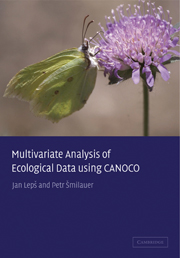Book contents
- Frontmatter
- Contents
- Preface
- 1 Introduction and data manipulation
- 2 Experimental design
- 3 Basics of gradient analysis
- 4 Using the Canoco for Windows 4.5 package
- 5 Constrained ordination and permutation tests
- 6 Similarity measures
- 7 Classification methods
- 8 Regression methods
- 9 Advanced use of ordination
- 10 Visualizing multivariate data
- 11 Case study 1: Variation in forest bird assemblages
- 12 Case study 2: Search for community composition patterns and their environmental correlates: vegetation of spring meadows
- 13 Case study 3: Separating the effects of explanatory variables
- 14 Case study 4: Evaluation of experiments in randomized complete blocks
- 15 Case study 5: Analysis of repeated observations of species composition from a factorial experiment
- 16 Case study 6: Hierarchical analysis of crayfish community variation
- 17 Case study 7: Differentiating two species and their hybrids with discriminant analysis
- Appendix A Sample datasets and projects
- Appendix B Vocabulary
- Appendix C Overview of available software
- References
- Index
10 - Visualizing multivariate data
Published online by Cambridge University Press: 09 February 2010
- Frontmatter
- Contents
- Preface
- 1 Introduction and data manipulation
- 2 Experimental design
- 3 Basics of gradient analysis
- 4 Using the Canoco for Windows 4.5 package
- 5 Constrained ordination and permutation tests
- 6 Similarity measures
- 7 Classification methods
- 8 Regression methods
- 9 Advanced use of ordination
- 10 Visualizing multivariate data
- 11 Case study 1: Variation in forest bird assemblages
- 12 Case study 2: Search for community composition patterns and their environmental correlates: vegetation of spring meadows
- 13 Case study 3: Separating the effects of explanatory variables
- 14 Case study 4: Evaluation of experiments in randomized complete blocks
- 15 Case study 5: Analysis of repeated observations of species composition from a factorial experiment
- 16 Case study 6: Hierarchical analysis of crayfish community variation
- 17 Case study 7: Differentiating two species and their hybrids with discriminant analysis
- Appendix A Sample datasets and projects
- Appendix B Vocabulary
- Appendix C Overview of available software
- References
- Index
Summary
The primary device for presenting the results of an ordination model is the ordination diagram. The contents of an ordination diagram can be used to approximate the species data table, the matrix of distances between individual samples, or the matrix of correlations or dissimilarities between individual species. In ordination analysis including environmental variables, we can use the ordination diagram to approximate the contents of the environmental data table, the relationship between the species and the environmental variables, the correlations among environmental variables, etc. The following two sections summarize what we can deduce from ordination diagrams that result from linear and unimodal ordination methods.
Before we discuss rules for interpreting ordination diagrams, we must stress that the absolute values of coordinates of objects (samples, species, explanatory variables) in ordination space do not have, in general, any meaning. When interpreting ordination diagrams, we use relative distances, relative directions, or relative ordering of projection points.
What we can infer from ordination diagrams: linear methods
An ordination diagram based on a linear ordination method (PCA or RDA) can display scores for samples (represented by symbols), species (represented by arrows), quantitative environmental variables (represented by arrows) and nominal dummy variables (represented by points – centroids – corresponding to the individual levels of a factor variable). Table 10–1 (after Ter Braak 1994) summarizes what can be deduced from ordination diagrams based on these scores. Additionally, the meaning of the length of species arrows in the two types of ordination scaling is discussed, and information about calculating the radius of the equilibrium contribution circle is given.
- Type
- Chapter
- Information
- Multivariate Analysis of Ecological Data using CANOCO , pp. 149 - 167Publisher: Cambridge University PressPrint publication year: 2003
- 2
- Cited by



